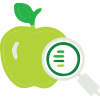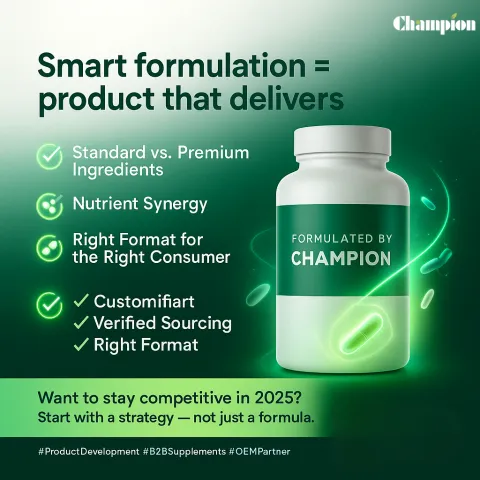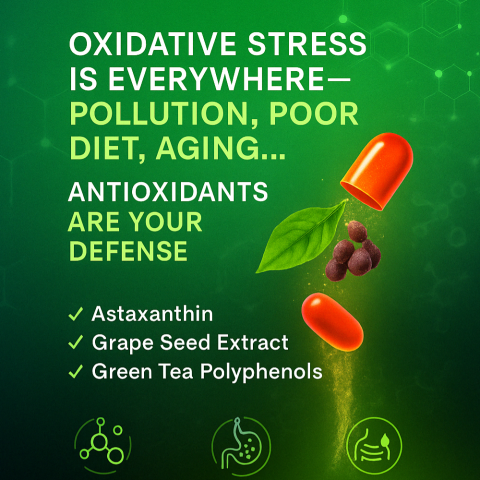Blog
29.Apr.2025
Ingredient Spotlight: Why Standardization Matters in Botanical Extracts
Not All Herbal Extracts Are Created Equal: The Power of Standardization in Nutraceuticals
Herbal supplements have long been praised for their natural origins and therapeutic benefits. But in today’s highly competitive and regulatory-intensive nutraceutical market, not all herbal extracts are created equal.The key factor that separates a science-backed, consumer-trusted herbal product from the rest is one word: standardization.
At Champion, we believe that delivering reliable health outcomes starts with delivering reliable ingredients. That’s why we source only from vetted botanical partners, and every extract we work with undergoes rigorous in-house testing for consistency, potency, and compliance.
In this article, we’ll explore:
- What standardization really means in herbal formulation
- Why it matters from a scientific, regulatory, and consumer trust standpoint
- How Champion integrates standardization into every stage of product development
- What trends are shaping the future of botanical supplements
What Is Standardization in Herbal Supplements?
Standardization is the process of ensuring that each batch of an herbal extract contains a specific and consistent level of active compounds—the bioactives responsible for the supplement’s health effects.For example:
- Turmeric extract might be standardized to contain 95% curcuminoids
- Milk thistle to 80% silymarin
- Ginkgo biloba to 24% flavone glycosides and 6% terpene lactones
- Ashwagandha to 5% withanolides
Without standardization, a product made from the same plant species can vary widely depending on:
- Soil conditions
- Harvest timing
- Plant part used (leaf vs. root)
- Extraction method
Why Standardization Matters
-
Ensures Consistent Therapeutic Effect
Negative reviews
Reduced repeat purchases
Long-term brand damage
Standardized herbal extracts solve this by delivering repeatable, measurable doses of active ingredients—ensuring every customer receives the benefit they paid for.
For example, turmeric root powder might contain only 2–5% curcuminoids, whereas a standardized extract delivers 95%. That difference dramatically impacts anti-inflammatory activity, absorption, and clinical effectiveness.
-
Enables Reliable Clinical Claims
For example: If a study shows that 300 mg of 95% curcuminoids reduced joint pain in 6 weeks, your formulation must use the same extract level to cite it legally and ethically.
Without standardization, your health claims can’t be backed by science—leaving you vulnerable to:
- Regulatory action from agencies like the FDA, EFSA, or ASEAN authorities
- Product delistings from e-commerce platforms
- Loss of consumer trust
-
Enhances Consumer Trust and Brand Credibility
Over 70% of supplement users check ingredient sourcing and dosage before purchasing (Innova Market Insights, 2023)
When you use standardized herbal extracts, you can confidently include:
- Exact bioactive percentages on your label
- Consistency claims like “standardized for 50% EGCG” or “backed by clinical studies”
- Clean-label appeal with added transparency and traceability
How Herbal Extracts Are Standardized
The standardization process involves several critical steps:-
1. Botanical Sourcing
-
2. Extraction
-
3. Enrichment
-
4. Testing and Validation
- High-Performance Liquid Chromatography (HPLC)
- UV-Vis spectrometry
- Mass spectrometry
These tests ensure the extract consistently meets the specified active level before being released into production.
-
5. Formulation and Delivery
Why Brands Skip Standardization (And Why You Shouldn’t)
We often see new or cost-sensitive brands skipping standardization in favor of raw herbal powders. While this may save money in the short term, it often results in:- Poor customer satisfaction and low efficacy
- Inability to support health claims
- Regulatory and compliance issues
- Higher return rates and reputational risk
Champion’s Approach to Botanical Standardization
At Champion, our approach goes beyond supply—we partner with our clients to ensure that every herbal product is:- 🌿 Consistent in potency and purity
- 📄 Backed by documentation and clinical support
- 🔬 Validated with third-party and in-house testing
- 🌏 Compliant with global market requirements (U.S., EU, ASEAN, GCC)
- Ingredient vetting
- Formulation compatibility
- Regulatory consulting
- Final QC release testing
What’s Next? Trends in Herbal Standardization
Looking ahead, we see several exciting trends:1. Green Extraction Technologies
Solvent-free and CO2-based processes reduce environmental impact and chemical residues2. Fermented Botanicals
Natural fermentation processes are being used to enhance bioavailability and standardize metabolite content for ingredients like Ginseng, Reishi, and Turmeric3. Clinical-Grade Botanicals
More brands are demanding clinical-ready herbal ingredients with published human trials, traceable sourcing, and integrated documentation4. Multifunctional Standardization
New ingredients are being standardized for multiple compounds (e.g., 5% Withanolides + 1% Alkaloids), allowing for broader health claimsAt Champion, we’re helping clients harness these next-gen standardized botanicals to stand out and scale with confidence.
Conclusion: Reliable Supplements Start with Reliable Extracts
In a market flooded with low-quality herbal products, standardization is what separates leaders from everyone else.When you formulate with standardized extracts, you:
- Deliver consistent health benefits
- Build scientific credibility
- Stay compliant globally
- Win long-term consumer trust
📩 Ready to develop herbal supplements with clinical-level confidence?
Let’s talk standardization, sourcing, and formulation strategy that sets your brand apart.






















